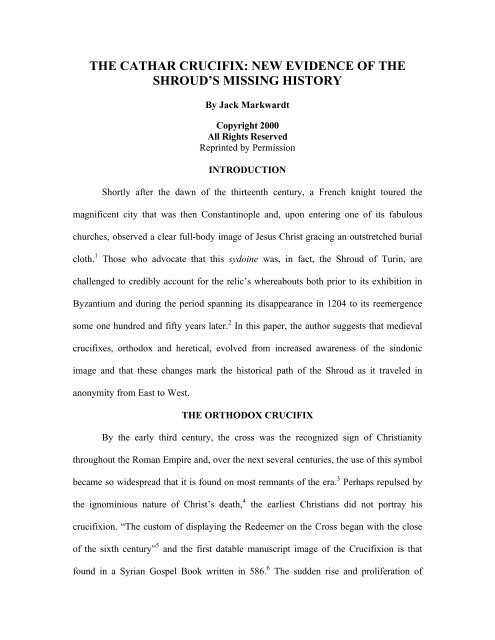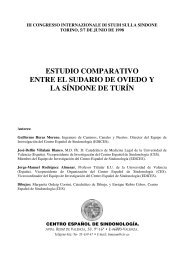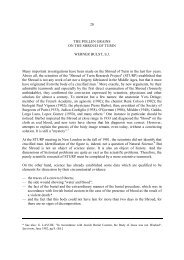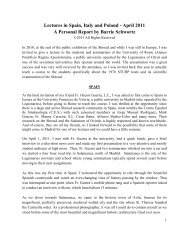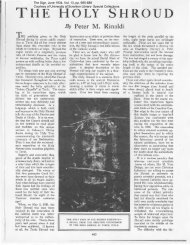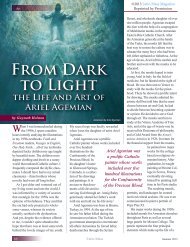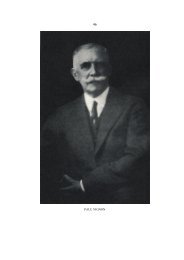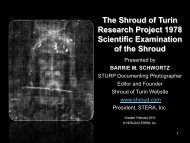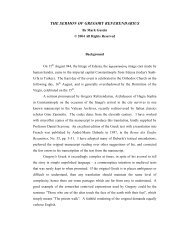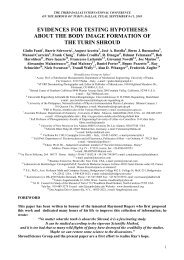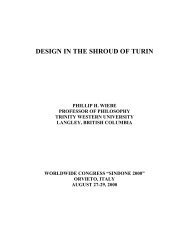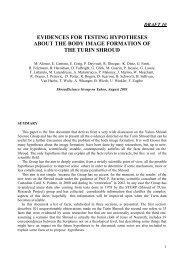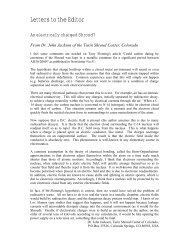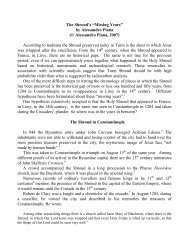the cathar crucifix - The Shroud of Turin
the cathar crucifix - The Shroud of Turin
the cathar crucifix - The Shroud of Turin
You also want an ePaper? Increase the reach of your titles
YUMPU automatically turns print PDFs into web optimized ePapers that Google loves.
THE CATHAR CRUCIFIX: NEW EVIDENCE OF THE<br />
SHROUD’S MISSING HISTORY<br />
By Jack Markwardt<br />
Copyright 2000<br />
All Rights Reserved<br />
Reprinted by Permission<br />
INTRODUCTION<br />
Shortly after <strong>the</strong> dawn <strong>of</strong> <strong>the</strong> thirteenth century, a French knight toured <strong>the</strong><br />
magnificent city that was <strong>the</strong>n Constantinople and, upon entering one <strong>of</strong> its fabulous<br />
churches, observed a clear full-body image <strong>of</strong> Jesus Christ gracing an outstretched burial<br />
cloth. 1 Those who advocate that this sydoine was, in fact, <strong>the</strong> <strong>Shroud</strong> <strong>of</strong> <strong>Turin</strong>, are<br />
challenged to credibly account for <strong>the</strong> relic’s whereabouts both prior to its exhibition in<br />
Byzantium and during <strong>the</strong> period spanning its disappearance in 1204 to its reemergence<br />
some one hundred and fifty years later. 2 In this paper, <strong>the</strong> author suggests that medieval<br />
<strong>crucifix</strong>es, orthodox and heretical, evolved from increased awareness <strong>of</strong> <strong>the</strong> sindonic<br />
image and that <strong>the</strong>se changes mark <strong>the</strong> historical path <strong>of</strong> <strong>the</strong> <strong>Shroud</strong> as it traveled in<br />
anonymity from East to West.<br />
THE ORTHODOX CRUCIFIX<br />
By <strong>the</strong> early third century, <strong>the</strong> cross was <strong>the</strong> recognized sign <strong>of</strong> Christianity<br />
throughout <strong>the</strong> Roman Empire and, over <strong>the</strong> next several centuries, <strong>the</strong> use <strong>of</strong> this symbol<br />
became so widespread that it is found on most remnants <strong>of</strong> <strong>the</strong> era. 3 Perhaps repulsed by<br />
<strong>the</strong> ignominious nature <strong>of</strong> Christ’s death, 4 <strong>the</strong> earliest Christians did not portray his<br />
<strong>crucifix</strong>ion. “<strong>The</strong> custom <strong>of</strong> displaying <strong>the</strong> Redeemer on <strong>the</strong> Cross began with <strong>the</strong> close<br />
<strong>of</strong> <strong>the</strong> sixth century” 5 and <strong>the</strong> first datable manuscript image <strong>of</strong> <strong>the</strong> Crucifixion is that<br />
found in a Syrian Gospel Book written in 586. 6 <strong>The</strong> sudden rise and proliferation <strong>of</strong>
<strong>crucifix</strong>es, beginning in <strong>the</strong> late sixth century, was countenanced by <strong>the</strong> Church which<br />
<strong>of</strong>ficially decreed, a century later, that Christ should be represented only “in human<br />
form”. 7 Concurrently, <strong>the</strong> first <strong>of</strong> two distinctly recognized periods <strong>of</strong> <strong>crucifix</strong>ion art<br />
commenced and extended for <strong>the</strong> next seven hundred years. 8<br />
During this period, Christ was initially shown crucified in a robe or a colobium (a<br />
long, flowing, sleeveless tunic extending to <strong>the</strong> knees) 9 and seemed adhered to his cross,<br />
with eyes open and head erect, alive, triumphant, and evincing no agony. 10 <strong>The</strong> ninth<br />
century saw, in <strong>the</strong> West, <strong>the</strong> colobium shortened to a perizoma (a garment extending<br />
from <strong>the</strong> waist to <strong>the</strong> knees) 11 and, primarily in <strong>the</strong> East, a dead Christ with closed eyes. 12<br />
<strong>The</strong>n suddenly in <strong>the</strong> eleventh-century, <strong>the</strong> Byzantines placed a suffering Christ on <strong>the</strong><br />
cross, crowned his head with thorns, showed blood flowing from his wounds, 13 and added<br />
a Roman centurion to <strong>the</strong>ir <strong>crucifix</strong>ion iconography 14<br />
Throughout this period, <strong>crucifix</strong>es generally reflected three ancient Church<br />
traditions. <strong>The</strong> first held that Jesus 15 had been hung on a crux immissa 16 comprised <strong>of</strong> an<br />
upright stipes extending above a horizontal patibulum, 17 reflecting universal belief that<br />
Christ’s hands had been affixed with nails to a crossbeam. <strong>The</strong> second held that Christ<br />
had been fastened to his cross with four nails. 18 <strong>The</strong> third held that, after Christ had<br />
expired on <strong>the</strong> cross, he was wounded in his right side 19 with a Roman lance. 20 <strong>The</strong> first<br />
two <strong>of</strong> <strong>the</strong>se traditions were ratified, in <strong>the</strong> early thirteenth century, by Pope Innocent III 21<br />
and all seemed validated by both <strong>the</strong> Volto Santo <strong>crucifix</strong> image, reputedly carved by<br />
Nicodemus from an impression left on <strong>the</strong> <strong>Shroud</strong>, 22 and also <strong>the</strong> stigmata <strong>of</strong> Francis <strong>of</strong><br />
Assisi. 23<br />
2
<strong>The</strong>n, in <strong>the</strong> early part <strong>of</strong> <strong>the</strong> thirteenth century, a new period <strong>of</strong> <strong>crucifix</strong>ion art<br />
commenced 24 when Western portrayals suddenly began to stress Christ’s suffering 25 and<br />
death on <strong>the</strong> cross. 26 Ancient traditions and Papal admonitions notwithstanding, <strong>the</strong><br />
crucified Lord’s feet were now pierced by only one nail. 27 In addition, his legs were<br />
crossed, his head bowed, 28 and his body arched. 29 At precisely this same time, Western<br />
churchmen began to stress that Christ had hung completely naked on <strong>the</strong> cross and had<br />
bowed his head at <strong>the</strong> moment <strong>of</strong> death. 30 By 1260, <strong>the</strong> living Christ had virtually<br />
disappeared from Western <strong>crucifix</strong>ion art. 31<br />
THE CATHAR CRUCIFIX<br />
In 1207, Pope Innocent III proclaimed <strong>the</strong> Albigensian Crusade in an attempt to<br />
eradicate <strong>the</strong> Cathar heresy that had been spreading throughout Languedoc for nearly half<br />
a century. 32 When orthodox armies marched into <strong>the</strong> south <strong>of</strong> France in 1209, <strong>the</strong> Cathar<br />
hierarchy took refuge in <strong>the</strong> mountain fortress <strong>of</strong> Montsegur. 33 As <strong>the</strong> bloody crusade<br />
continued to be prosecuted, many Cathars fled to neighboring Spain and, by 1218, a<br />
numerous and well-organized group <strong>of</strong> heretics had settled in <strong>the</strong> city <strong>of</strong> Leon 34 where<br />
<strong>the</strong>y were confronted by a Catholic prelate known to posterity as Lucas <strong>of</strong> Tuy. 35<br />
Born in <strong>the</strong> middle <strong>of</strong> <strong>the</strong> twelfth century, Lucas became a priest 36 and was<br />
assigned to <strong>the</strong> Church <strong>of</strong> Saint Isidoro in Leon. 37 <strong>The</strong>re he confronted <strong>the</strong> Cathars 38 and,<br />
unaided by <strong>the</strong> Inquisition, 39 personally destroyed a chapel that <strong>the</strong> heretics had erected in<br />
honor <strong>of</strong> one <strong>of</strong> <strong>the</strong>ir martyrs. 40 Between 1229 and 1234, 41 Lucas wrote De Altera Vita,<br />
Adversus Albigensium Errores (<strong>The</strong> O<strong>the</strong>r Life, Against <strong>the</strong> Errors <strong>of</strong> <strong>the</strong> Albigensians) 42<br />
which detailed various Cathar tenets and religious practices 43 and betrayed his own<br />
pathological hatred <strong>of</strong> heretics 44 and Jews. 45<br />
3
In De Altera Vita, Lucas reports that <strong>the</strong> Cathars manufactured a most unusual<br />
<strong>crucifix</strong>. At that time, <strong>the</strong> traditional orthodox <strong>crucifix</strong> consisted <strong>of</strong> four arms (i.e., pieces<br />
<strong>of</strong> wood) which formed an upright stipes, a horizontal patibulum, a titulus above <strong>the</strong><br />
head, and a suppedaneum to support <strong>the</strong> body at <strong>the</strong> feet. 46 Lucas relates that <strong>the</strong> Cathars<br />
removed <strong>the</strong> “upper arm” <strong>of</strong> <strong>the</strong> orthodox <strong>crucifix</strong> 47 in order to mutilate <strong>the</strong> traditional<br />
sign <strong>of</strong> <strong>the</strong> cross. 48 Protesting against this heretical invention, Lucas argues that a proper<br />
cross must take <strong>the</strong> shape <strong>of</strong> overlapping arms, 49 represent <strong>the</strong> four regions <strong>of</strong> <strong>the</strong> earth, 50<br />
and reflect <strong>the</strong> symbol that had adorned imperial crowns. 51 He also claimed that <strong>the</strong><br />
stigmata <strong>of</strong> Francis <strong>of</strong> Assisi had validated <strong>the</strong> shape <strong>of</strong> <strong>the</strong> orthodox <strong>crucifix</strong>. 52 Lucas<br />
<strong>the</strong>reby ra<strong>the</strong>r clearly indicates that <strong>the</strong> Cathars had removed <strong>the</strong> patibulum from <strong>the</strong><br />
orthodox <strong>crucifix</strong> and, in doing so, created a so-called crux simplex, comprised <strong>of</strong> a<br />
vertical stake, an inscription plate, and a footrest. Lucas notes too that <strong>the</strong> Cathar <strong>crucifix</strong><br />
portrayed Christ attached to <strong>the</strong> cross with only three nails, one <strong>of</strong> which was driven<br />
through his crossed feet, 53 and that <strong>the</strong> heretics had claimed that Christ was pierced in his<br />
left side by a Roman lance. 54 Based upon <strong>the</strong> foregoing, I believe that <strong>the</strong> Cathar <strong>crucifix</strong><br />
depicted Jesus wounded in <strong>the</strong> left side and hung from a crux simplex, with his arms<br />
extended directly above his head and his hands (or wrists) nailed to <strong>the</strong> upright stipes.<br />
In <strong>the</strong> light <strong>of</strong> known Cathar religious tenets and practices, 55 this heretical <strong>crucifix</strong><br />
raises a number <strong>of</strong> questions. For example, <strong>the</strong> Cathars clearly held religious images and<br />
relics in low esteem. 56 Given <strong>the</strong>ir strong aversion to images, <strong>the</strong> Cathars should not have<br />
created such a religious image-bearing object, and yet Lucas, an avid proponent <strong>of</strong> relics<br />
and holy images, 57 confirms that <strong>the</strong>y did precisely that. Given too <strong>the</strong> unchallenged<br />
predominance <strong>of</strong> ancient <strong>crucifix</strong>ion traditions dictating <strong>the</strong> shape <strong>of</strong> <strong>the</strong> Cross, <strong>the</strong><br />
4
number <strong>of</strong> nails, and <strong>the</strong> location <strong>of</strong> <strong>the</strong> lance wound, <strong>the</strong> Cathars should have embraced<br />
at least one <strong>of</strong> <strong>the</strong>se ancient teachings, and yet, <strong>the</strong>y did precisely <strong>the</strong> opposite.<br />
<strong>The</strong> Cathars believed in two distinct deities, one good who made spiritual things<br />
and <strong>the</strong> o<strong>the</strong>r evil who created <strong>the</strong> things <strong>of</strong> this world. 58 Because <strong>the</strong>y deemed mankind<br />
itself <strong>the</strong> work <strong>of</strong> <strong>the</strong> devil, <strong>the</strong> Cathars pr<strong>of</strong>essed that Jesus had inhabited a simulacrum;<br />
i.e., a mere representation <strong>of</strong> a human body. 59 Consequently, <strong>the</strong>y preached that Christ<br />
had been a ghost 60 who only appeared human and, consistent with Docetic heresies,<br />
claimed that nei<strong>the</strong>r his death nor his resurrection had been a physical reality. 61 Having<br />
rejected <strong>the</strong> reality <strong>of</strong> Christ’s incarnation, <strong>the</strong> Cathars were logically compelled to<br />
disclaim <strong>the</strong> Eucharist, 62 <strong>the</strong> doctrine <strong>of</strong> transubstantiation, 63 and <strong>the</strong> Mass with its<br />
sacrifices <strong>of</strong> <strong>the</strong> altar. 64<br />
Once <strong>the</strong>y had repudiated Christ’s human nature, <strong>the</strong> Cathars should have viewed<br />
his <strong>crucifix</strong>ion as nothing more than a mirage, and yet <strong>the</strong>y were palpably frightened by<br />
<strong>the</strong> event and claimed that <strong>the</strong> Cross should inspire horror, since it had formed <strong>the</strong><br />
instrument <strong>of</strong> Jesus’ humiliation. As noted by medieval scholar, Zoë Oldenbourg, such<br />
reasoning demonstrates that <strong>the</strong> Cathars did, in fact, attach much more importance to <strong>the</strong><br />
Crucifixion than is generally supposed and that <strong>the</strong>y believed, in some way or o<strong>the</strong>r, in<br />
<strong>the</strong> real sufferings <strong>of</strong> Jesus and his death on <strong>the</strong> cross. 65<br />
Finally, given <strong>the</strong>ir rejection <strong>of</strong> <strong>the</strong> Eucharist and <strong>the</strong> Mass, <strong>the</strong> Cathars should not<br />
have claimed to possess Christ’s transubstantiated body, and yet <strong>the</strong>y did invite <strong>the</strong> leader<br />
<strong>of</strong> <strong>the</strong> Albigensian Crusade to see <strong>the</strong> body <strong>of</strong> Christ that had become flesh and blood in<br />
<strong>the</strong> hands <strong>of</strong> <strong>the</strong>ir priest. 66<br />
5
SINDONIC SOLUTIONS<br />
Some have attributed <strong>the</strong> sudden popularity <strong>of</strong> <strong>crucifix</strong>es in <strong>the</strong> late sixth century,<br />
as well as <strong>the</strong> Church’s tolerance <strong>of</strong> <strong>the</strong>ir use, to an orthodox attempt to oppose certain<br />
heresies which proclaimed that Christ was possessed <strong>of</strong> a divine nature only and had<br />
never been subject to human vulnerability. While religious images <strong>of</strong> Christ, as a real<br />
man affixed to a cross, might aid in checking <strong>the</strong> spread <strong>of</strong> such heretical doctrines, it has<br />
been recognized that this explanation alone does not adequately account for <strong>the</strong> sudden<br />
popularity <strong>of</strong> <strong>crucifix</strong>es in <strong>the</strong> late sixth century. 67<br />
In 544, an image <strong>of</strong> Christ "not made by human hands" appeared in Edessa during<br />
<strong>the</strong> siege <strong>of</strong> that city by <strong>the</strong> Persian army. Ian Wilson has persuasively demonstrated that<br />
this icon was <strong>the</strong> <strong>Shroud</strong> 68 and I have previously suggested that <strong>the</strong> orthodox clergy <strong>of</strong><br />
Edessa was well aware <strong>of</strong> <strong>the</strong> cloth’s full-body image before converting it into a “folded-<br />
in-four” portrait. 69 I propose that it was this startling debut <strong>of</strong> a miraculous image <strong>of</strong><br />
Christ crucified that inspired <strong>the</strong> popularity <strong>of</strong> <strong>crucifix</strong>es and persuaded <strong>the</strong> Church to<br />
countenance <strong>the</strong>ir use and proliferation beginning in <strong>the</strong> late sixth century. After all, if<br />
Christ himself had allowed his crucified body to be manifested on cloth, how could his<br />
Church rationally oppose <strong>the</strong> manufacture <strong>of</strong> o<strong>the</strong>r representations <strong>of</strong> this salvitic event?<br />
So long as <strong>the</strong> portraited <strong>Shroud</strong>, known as <strong>the</strong> Image <strong>of</strong> Edessa, was kept “folded<br />
in four”, modesty-minded Christians, 70 unaware <strong>of</strong> <strong>the</strong> naked sindonic body image, would<br />
continue to portray Jesus crucified in a robe, colobium, or perizoma. So long as <strong>the</strong><br />
extensive wounds caused by <strong>the</strong> whip, <strong>the</strong> thorns, <strong>the</strong> falls, and <strong>the</strong> lance remained<br />
hidden, reverent Christians could afford to imagine and depict <strong>the</strong>ir Savior adhered to his<br />
cross in triumphant glory.<br />
6
In Byzantine <strong>crucifix</strong>ion scenes dating from <strong>the</strong> eleventh century, however, a<br />
suffering Christ is substituted for <strong>the</strong> triumphant Christ, a crown <strong>of</strong> thorns appears on his<br />
head, blood flows from his wounds, and a Roman centurion is added to <strong>the</strong> standard<br />
<strong>crucifix</strong>ion motif. While such nuances are sometimes ascribed merely to <strong>the</strong> supposed<br />
mysticism <strong>of</strong> that era, it is undisputed that <strong>the</strong> Edessa icon arrived in Constantinople in<br />
944 and “an impressive array <strong>of</strong> circumstantial evidence” indicates that, prior to 1130, <strong>the</strong><br />
cloth was unfolded and its full-body image revealed. 71 I suggest that once <strong>the</strong> Byzantines<br />
<strong>the</strong>reby became aware <strong>of</strong> <strong>the</strong> severity <strong>of</strong> Christ’s injuries, 72 <strong>the</strong>y began to portray his<br />
sufferings and bloody wounds, and to stress <strong>the</strong> role <strong>of</strong> <strong>the</strong> centurion. This conclusion is<br />
supported by <strong>the</strong> correlative fact that, after <strong>the</strong> <strong>Shroud</strong> was presumably unfolded in<br />
Constantinople, Byzantine portrayals <strong>of</strong> Christ’s burial began to show him laid out in <strong>the</strong><br />
precise manner <strong>of</strong> <strong>the</strong> sindonic image with his hands crossed below his waist. 73<br />
<strong>The</strong> ra<strong>the</strong>r dramatic developments in Western <strong>crucifix</strong>ion art <strong>of</strong> <strong>the</strong> early<br />
thirteenth century, when a suffering Christ was depicted as crucified with three nails,<br />
have been ascribed to artistic purposes 74 and to <strong>the</strong> philosophies <strong>of</strong> new found religious<br />
orders. 75 Never<strong>the</strong>less, it is clear that <strong>the</strong> full-body sindonic image had continued to<br />
escape Western attention until 1203 when, confronted by a military threat to<br />
Constantinople, <strong>the</strong> Emperor publicly exhibited <strong>the</strong> sydoine to French crusaders and <strong>the</strong><br />
Italian seamen who had ferried <strong>the</strong>m to Byzantium. <strong>The</strong>refore, I suggest that it was recent<br />
acquaintance with <strong>the</strong> sindonic image that precipitated <strong>the</strong> new Western emphasis, in<br />
both art and ecclesiastical literature, upon a naked, suffering, head-bowed Christ crucified<br />
with three nails.<br />
7
Ian Wilson has proposed that, as Constantinople was being sacked in 1204, <strong>the</strong><br />
<strong>Shroud</strong> fell into <strong>the</strong> hands <strong>of</strong> <strong>the</strong> Knights Templar. He has ascribed <strong>the</strong> Templars’<br />
subsequent anonymous ownership <strong>of</strong> <strong>the</strong> cloth to <strong>the</strong>ir inherently secretive nature and<br />
noted that <strong>the</strong> Order ultimately came to venerate a mysterious bearded head idol and<br />
produce a martyred leader with familial links to Ge<strong>of</strong>frey de Charny, <strong>the</strong> <strong>Shroud</strong>’s first<br />
record owner. 76<br />
Convinced that Wilson had correctly deduced that <strong>the</strong> <strong>Shroud</strong>’s missing medieval<br />
owners were Christians connected to both Constantinople and Charny and positioned to<br />
resist <strong>the</strong> lucrative relic market for five-plus generations, 77 I recently nominated <strong>the</strong><br />
Cathars as <strong>the</strong> <strong>Shroud</strong>’s pre-Lirey custodians. 78 Allied with Byzantine dualists, 79 <strong>the</strong>se<br />
heretics were scornful <strong>of</strong> pecuniary pr<strong>of</strong>it, compelled by persecution to conceal <strong>the</strong> relic,<br />
and subject to forfeiture laws 80 that would have legally brought <strong>the</strong> <strong>Shroud</strong> to Charny, via<br />
royal grant, 81 during <strong>the</strong> era <strong>of</strong> <strong>the</strong> Black Death. 82 In deference to traditional scholarship<br />
that <strong>the</strong> Cathars loa<strong>the</strong>d religious images and relics, I suggested that <strong>the</strong>y had acquired<br />
<strong>the</strong> <strong>Shroud</strong> as a protective palladium 83 against <strong>the</strong> Roman Church that sought <strong>the</strong>ir<br />
extinction through persecution and military crusade. In support <strong>of</strong> my <strong>the</strong>ory, I cited<br />
contemporary romances 84 seemingly placing <strong>the</strong> Holy Grail 85 in Cathar Montsegur,<br />
Inquisition testimony recounting <strong>the</strong> surreptitious removal <strong>of</strong> an unidentified treasure<br />
from that fortress, 86 a chronicle reporting Cathar possession <strong>of</strong> Christ’s body and blood, 87<br />
and a heretical <strong>crucifix</strong> having only three nails. 88<br />
Heret<strong>of</strong>ore, I have mentioned several seeming contradictions between Cathar<br />
beliefs, on <strong>the</strong> one hand, and Cathar deeds, on <strong>the</strong> o<strong>the</strong>r; however, I believe that all <strong>of</strong> <strong>the</strong><br />
Cathars’ actions are reconcilable with <strong>the</strong> transfer <strong>of</strong> <strong>the</strong> <strong>Shroud</strong> from Constantinople to<br />
8
Languedoc in 1204. I suggest that, upon receiving <strong>the</strong> relic from <strong>the</strong>ir brethren in<br />
Byzantium, <strong>the</strong> Cathars discovered, within its incredible image, irrefutable pro<strong>of</strong> that<br />
Jesus <strong>of</strong> Nazareth had truly been a living human being. Such graphic evidence would<br />
have surely dispelled <strong>the</strong>ir notion that Christ had been only a ghost, caused <strong>the</strong>m to<br />
accept <strong>the</strong> reality <strong>of</strong> his suffering and death on <strong>the</strong> cross, and given rise to <strong>the</strong>ir mortal<br />
dread <strong>of</strong> his <strong>crucifix</strong>ion. I believe that <strong>the</strong> Cathars’ claim to possess <strong>the</strong> body and blood <strong>of</strong><br />
Christ, which simply could not have referred to transubstantiated bread and wine, was<br />
made in reference to an imaged cloth that, when lifted up and unfolded by <strong>the</strong>ir priest,<br />
manifested a mysterious representation <strong>of</strong> Christ crucified.<br />
So too is <strong>the</strong> Cathar <strong>crucifix</strong> to be understood and explained. While modern<br />
sindonologists are cognizant <strong>of</strong> medical evidence indicating that Christ’s arms were<br />
extended horizontally and appreciate that <strong>the</strong> <strong>Shroud</strong> image mirrors <strong>the</strong> position <strong>of</strong> <strong>the</strong><br />
body it once enveloped, thirteenth-century Cathars were ignorant <strong>of</strong> such medical<br />
considerations and probably failed to perceive <strong>the</strong> reverse perspective characteristics <strong>of</strong><br />
<strong>the</strong> image. 89 I suggest that, convinced by <strong>the</strong> sindonic image that Jesus had been crucified<br />
with his hands nailed above his head, his crossed feet affixed by one nail, 90 and his left<br />
side pierced, <strong>the</strong> Cathars created a <strong>crucifix</strong> with no patibulum, three nails, and a wound to<br />
<strong>the</strong> left side.<br />
In his classic study <strong>of</strong> <strong>the</strong> medieval Inquisition, Charles Henry Lea concluded that<br />
<strong>the</strong> Cathar <strong>crucifix</strong> was employed to proselytize orthodox believers. 91 This was based<br />
upon Lucas’ report that <strong>the</strong> heretical <strong>crucifix</strong> had been employed to confuse <strong>the</strong> Catholic<br />
laity 92 and make <strong>the</strong>m question <strong>the</strong>ir faith. 93 Lucas also related, however, that <strong>the</strong> Cathars<br />
attempted to propagate <strong>the</strong>ir heretical beliefs through paintings <strong>of</strong> <strong>the</strong> Holy Trinity that<br />
9
illustrated multiple gods and Christ’s subordination to his Fa<strong>the</strong>r. 94 <strong>The</strong>refore, since <strong>the</strong><br />
Cathars were clearly inclined to employ religious objects to spread <strong>the</strong>ir <strong>the</strong>ological<br />
beliefs, I suggest that <strong>the</strong> Cathar <strong>crucifix</strong> reflected <strong>the</strong>ir newfound acceptance <strong>of</strong> <strong>the</strong><br />
reality <strong>of</strong> Christ’s <strong>crucifix</strong>ion and that its unconventional features were based entirely<br />
upon <strong>the</strong> authority <strong>of</strong> <strong>the</strong> sindonic image. 95<br />
CONCLUSION<br />
Medieval <strong>crucifix</strong>es, orthodox and heretical, underwent evolutionary changes as<br />
<strong>the</strong> Christian world became increasingly aware <strong>of</strong> <strong>the</strong> <strong>crucifix</strong>ion details evinced by <strong>the</strong><br />
sindonic image. By identifying significant revisions to <strong>the</strong> <strong>crucifix</strong> and to <strong>crucifix</strong>ion art,<br />
it is possible to discover <strong>the</strong> historical path taken by <strong>the</strong> <strong>Shroud</strong> as it traveled, in<br />
anonymity, from place to place.<br />
<strong>The</strong> late sixth-century rise in <strong>the</strong> popularity <strong>of</strong> <strong>crucifix</strong>es and <strong>the</strong>ir acceptance by<br />
<strong>the</strong> Church reflects <strong>the</strong> fact that, in 544, <strong>the</strong> <strong>Shroud</strong> surfaced in Edessa. <strong>The</strong> early<br />
eleventh-century shift in Byzantine <strong>crucifix</strong>ion portrayals to a suffering Christ crowned<br />
with thorns and bleeding from his wounds reflects <strong>the</strong> fact that, in 944, <strong>the</strong> <strong>Shroud</strong> was<br />
taken from Edessa to Constantinople. <strong>The</strong> early thirteenth-century shift in Western<br />
<strong>crucifix</strong>ion portrayals to a suffering Christ crucified with three nails and <strong>the</strong> newborn<br />
emphasis in ecclesiastical literature upon a naked and head-bowed Christ reflect <strong>the</strong> fact<br />
that, in 1203, <strong>the</strong> <strong>Shroud</strong> was publicly exhibited in Constantinople. <strong>The</strong> early thirteenth-<br />
century appearance <strong>of</strong> a Cathar <strong>crucifix</strong> having no crossbeam, three nails, and a left side<br />
wound reflects <strong>the</strong> fact that, in 1204, <strong>the</strong> <strong>Shroud</strong> was taken from Constantinople to<br />
Languedoc.<br />
10
BIBLIOGRAPHY<br />
Costen, Michael, <strong>The</strong> Cathars and <strong>the</strong> Albigensian Crusade, Manchester University Press<br />
(Manchester, 1997).<br />
Currer-Briggs, Noel, <strong>The</strong> <strong>Shroud</strong> and <strong>the</strong> Grail, Weidenfeld and Nicolson (London,<br />
1987).<br />
Drews, Robert, In Search <strong>of</strong> <strong>the</strong> <strong>Shroud</strong> <strong>of</strong> <strong>Turin</strong>, Rowman & Allanheld (Totowa, 1984).<br />
Gottfried, Robert S., <strong>The</strong> Black Death, <strong>The</strong> Free Press (New York, 1983).<br />
Hamilton, Bernard, Monastic Reform, Catharism and <strong>the</strong> Crusades (900-1300),<br />
Variorum Reprints (London, 1979).<br />
Hamilton, Janet and Hamilton, Bernard, Christian Dualist Heresies in <strong>the</strong> Byzantine<br />
World c. 650-c. 1405, Manchester University Press (New York, 1998).<br />
Joinville, Jean de, <strong>The</strong> History <strong>of</strong> St. Louis (trans.) Joan Evans, Oxford University Press<br />
(London, 1938).<br />
Jones, Doug, Crucifix, <strong>The</strong> Dictionary <strong>of</strong> Art (ed.) Jane Turner, Vol. 8, Macmillan<br />
Publishers Ltd. (London, 1996).<br />
Lea, Henry Charles, A History <strong>of</strong> <strong>the</strong> Inquisition <strong>of</strong> <strong>the</strong> Middle Ages, Harper & Bro<strong>the</strong>rs<br />
(New York, 1887).<br />
Lucas <strong>of</strong> Tuy, De Altera Vita, Adversus Albigensium Errrores, Magna Biblio<strong>the</strong>ca<br />
Veterum Patrum et Antiquorum Scriptorum Ecclesiasticorum (ed.) M. de La Bigne, Vol.<br />
4, Part 2, Cols. 635-714, J. Billaine, S. Piget, and F. Leonard (Paris, 1654).<br />
Madaule, Jacques, <strong>The</strong> Albigensian Crusade (trans.) Barbara Wall, Fordham University<br />
Press (New York, 1967).<br />
Marucchi, Orazio, Cross and Crucifix, Archaeology <strong>of</strong> <strong>the</strong> Cross, <strong>The</strong> Catholic<br />
Encyclopedia, Volume IV, Robert Appleton Company (New York, 1908).<br />
Oakes, Ca<strong>the</strong>rine, Crucifix, <strong>The</strong> Dictionary <strong>of</strong> Art (ed.) Jane Turner, Vol. 8, Macmillan<br />
Publishers Ltd. (London, 1996).<br />
Oldenbourg, Zoë, Massacre at Montsegur (trans.) Peter Green, Pan<strong>the</strong>on Books (New<br />
York, 1961).<br />
Schacher, A. A., Crucifixion (In Art), <strong>The</strong> New Catholic Encyclopedia, Vol. IV, McGraw<br />
Hill (New York, 1987).<br />
11
Strayer, Joseph R., <strong>The</strong> Albigensian Crusades, <strong>The</strong> Dial Press (New York, 1971).<br />
Sumption, Jonathan, <strong>The</strong> Albigensian Crusade, Faber & Faber (London, 1978).<br />
Warner, H.J., <strong>The</strong> Albigensian Heresy, Russell & Russell (New York, 1967).<br />
Wilson, Ian, <strong>The</strong> Blood and <strong>the</strong> <strong>Shroud</strong>, <strong>The</strong> Free Press (New York, 1998).<br />
Wilson, Ian, <strong>The</strong> <strong>Shroud</strong> <strong>of</strong> <strong>Turin</strong>, <strong>The</strong> Burial Cloth <strong>of</strong> Jesus Christ?, Image Books<br />
(Garden City, 1979).<br />
Wolfram, von Eschenbach, Parzival (trans.) Andre Lefevere, <strong>The</strong> Continuum Publishing<br />
Company (New York, 1991).<br />
NOTES<br />
1 Describing his experiences in 1203-04 Constantinople, Robert de Clari reported that<br />
“…<strong>the</strong>re was ano<strong>the</strong>r <strong>of</strong> <strong>the</strong> churches which <strong>the</strong>y called My Lady St. Mary <strong>of</strong> Blachernae,<br />
where was kept <strong>the</strong> sydoine in which Our Lord had been wrapped, which stood up<br />
straight every Friday so that <strong>the</strong> figure <strong>of</strong> Our Lord could be plainly seen <strong>the</strong>re…”.<br />
Wilson, <strong>The</strong> <strong>Shroud</strong> <strong>of</strong> <strong>Turin</strong>, p. 169, citing Robert de Clari, <strong>The</strong> Conquest <strong>of</strong><br />
Constantinople, p. 112, trans. E.H. McNeal (New York: Columbia University Press,<br />
1936).<br />
2 <strong>The</strong> <strong>Shroud</strong> can be traced, with a high degree <strong>of</strong> confidence, to its ownership by <strong>the</strong><br />
chivalrous French knight, Ge<strong>of</strong>frey de Charny, Lord <strong>of</strong> Lirey, in <strong>the</strong> mid-fourteenth<br />
century.<br />
3 Marucchi, p. 520; p. 526.<br />
4 <strong>The</strong> earliest Christians depicted <strong>the</strong> Crucifixion only in veiled forms, such as a lamb<br />
lying at <strong>the</strong> foot <strong>of</strong> an anchor, a dolphin entwined around a trident, and Ulysses tied to a<br />
mast. Marucchi, p. 527.<br />
5 Marucchi, p. 527.<br />
6 Codex Syriacus, 56, preserved in <strong>the</strong> Laurentian Library at Florence. Marucchi, p. 527;<br />
Schacher, p. 487.<br />
7 In 692, this decree was issued by <strong>the</strong> Quinisext Council <strong>of</strong> Constantinople. Marucchi, p.<br />
527; Schacher, p. 487.<br />
12
8 “In <strong>the</strong> artistic treatment <strong>of</strong> <strong>the</strong> <strong>crucifix</strong> <strong>the</strong>re are two periods: <strong>the</strong> first, which dates from<br />
<strong>the</strong> sixth to <strong>the</strong> twelfth and thirteenth centuries; and <strong>the</strong> second, dating from that time to<br />
our own day”. Marucchi, p. 529.<br />
9 <strong>The</strong> Syrian Gospel Book, mentioned heret<strong>of</strong>ore, shows a bearded Christ in a sleeveless<br />
tunic. Marucchi, p. 527. Schacher, p. 487. Similar portrayals are found in <strong>the</strong> Vatican<br />
oratory, built in 705 by Pope John VII, and on a <strong>crucifix</strong> dating from <strong>the</strong> time <strong>of</strong> Pope<br />
Paul I (757-768) which features a wide-eyed Christ draped in a long grayish-blue tunic.<br />
Marucchi, p. 528.<br />
10 “In a word, it is not Christ suffering, but Christ triumphing and glorious on <strong>the</strong> Cross.<br />
Moreover, Christian art for a long time objected to stripping Christ <strong>of</strong> his garments…”<br />
Marucchi, p. 529. <strong>The</strong> Gregory <strong>of</strong> Nazianzus <strong>of</strong> Paris, datable to about 880, has a<br />
colobium painted over a loincloth and provides <strong>the</strong> first, and a very rare early, Eastern<br />
example <strong>of</strong> a perizoma. Schacher, p. 487.<br />
11 <strong>The</strong> <strong>crucifix</strong> <strong>of</strong> Leo IV (840-847) portrays <strong>the</strong> crucified Christ with a perizoma.<br />
Marucchi, p. 529.<br />
12 Schacher, p. 487; however, during <strong>the</strong> Carolingian period, a dead Christ, showing no<br />
sign <strong>of</strong> suffering, appeared alongside <strong>the</strong> living Christ in Western art. Oakes, p. 210.<br />
13 “From <strong>the</strong> eleventh century in <strong>the</strong> East…, <strong>the</strong> head droops onto <strong>the</strong> breast, <strong>the</strong> crown <strong>of</strong><br />
thorns is introduced, <strong>the</strong> arms are bent back, <strong>the</strong> body is twisted, <strong>the</strong> face is wrung with<br />
agony, and blood flows from <strong>the</strong> wounds”. Marucchi, p. 529. “Iconographic precedents<br />
for <strong>the</strong> suffering Christ existed in such Byzantine works as <strong>the</strong> nar<strong>the</strong>x mosaic<br />
Crucifixion (c. 1025) at Hosios Loukas, Phokis, and among <strong>the</strong> icons at St Ca<strong>the</strong>rine’s<br />
Monastery, Sinai”. Jones, p. 212.<br />
14 A holy woman joins Mary and John at <strong>the</strong> foot <strong>of</strong> <strong>the</strong> cross. Schachter, p. 491.<br />
15 Helena, <strong>the</strong> mo<strong>the</strong>r <strong>of</strong> Emperor Constantine, brought <strong>the</strong> cross <strong>of</strong> <strong>the</strong> Good Thief from<br />
Jerusalem to Cyprus and <strong>the</strong> island was <strong>the</strong>reafter blessed copiously. This was seen to<br />
prove that <strong>the</strong> crosses <strong>of</strong> <strong>the</strong> two thieves had <strong>the</strong> same shape as Christ’s. Lucas <strong>of</strong> Tuy,<br />
Book II, Chapter 19.<br />
16 This tradition may have derived from <strong>the</strong> fact that a titulus had been placed over <strong>the</strong><br />
head <strong>of</strong> <strong>the</strong> crucified Christ. See Mat<strong>the</strong>w 27:37. Marucchi, p. 520. <strong>The</strong> prevalent Latin<br />
version <strong>of</strong> <strong>the</strong> crux immissa, with its transverse beam set two-thirds <strong>of</strong> <strong>the</strong> way up its<br />
vertical stake, was prevalent both in <strong>the</strong> West and <strong>the</strong> East and was employed at<br />
Constantinople’s Church <strong>of</strong> <strong>the</strong> Apostles, St. Ca<strong>the</strong>rine on Mount Sinai, and many<br />
churches located in A<strong>the</strong>ns. <strong>The</strong> Greek version had its transverse beam set at <strong>the</strong> center <strong>of</strong><br />
<strong>the</strong> vertical upright. Marucchi, pp. 521-522.<br />
17 Although some Christians venerated a T-shaped crux commissa, every <strong>crucifix</strong> featured<br />
a patibulum. Marucchi, pp. 521-522.<br />
13
18 In <strong>the</strong> sixth century, Gregory <strong>of</strong> Tours wrote: "Clavorum ergo dominicorum gratiâ<br />
quod quatuor fuerint hæc est ratio: duo sunt affixi in palmis, et duo in plantis". Gregory<br />
<strong>of</strong> Tours, De Gloriâ Martyrum, I, vi, in P.L., XXI, 710. Marucchi, p. 528. Two early<br />
examples <strong>of</strong> <strong>the</strong> four-nail <strong>crucifix</strong> are found in <strong>the</strong> seventh century crypt <strong>of</strong> St. Valentine's<br />
Catacomb on <strong>the</strong> Via Flaminia and in <strong>the</strong> <strong>crucifix</strong> <strong>of</strong> Pope Leo IV (840-847). Marucchi,<br />
pp. 528-529.<br />
19 “This should be enough to prove…that <strong>the</strong> lance pierced <strong>the</strong> Savior's right side. This at<br />
least is clearly <strong>the</strong> tradition <strong>of</strong> <strong>the</strong> Roman church, and <strong>the</strong> Greek and Armenian churches,<br />
as well as <strong>the</strong> oriental church.” Lucas <strong>of</strong> Tuy, Book II, Chapter 11.<br />
20 Although, <strong>the</strong> centurion was not typically added to Byzantine <strong>crucifix</strong>ion scenes until<br />
<strong>the</strong> eleventh century, he had been portrayed in both Syria and <strong>the</strong> West. On a ninthcentury<br />
ivory plaque set into <strong>the</strong> cover <strong>of</strong> <strong>the</strong> Pericope Book <strong>of</strong> Henry II, found in <strong>the</strong><br />
state library <strong>of</strong> Munich, Longinus is shown thrusting his lance into Christ’s right side.<br />
Schacher, p. 491. In <strong>the</strong> Syrian Gospel Book written in 586, <strong>the</strong> lance wound is on <strong>the</strong><br />
right side. Schacher, p. 487. On an ivory casket <strong>of</strong> <strong>the</strong> fifth century, found in <strong>the</strong> British<br />
Museum, Longinus prepares to thrust his lance into Christ’s left side and also, in <strong>the</strong><br />
eighth-century Irish Gospel Book <strong>of</strong> St. Gall, he appears to Christ’s left. Schacher, p.<br />
486; p. 491.<br />
21 “Let us <strong>the</strong>refore recall <strong>the</strong> words <strong>of</strong> <strong>the</strong> glorious Pope Innocent III, and let us listen to<br />
what he says in his book <strong>of</strong> sermons … about <strong>the</strong> cross …as if he himself were speaking.<br />
<strong>The</strong> Lord's cross consisted <strong>of</strong> four pieces <strong>of</strong> wood - <strong>the</strong> upright trunk, <strong>the</strong> crossbeam, a<br />
support for <strong>the</strong> body, and <strong>the</strong> inscription over his head.” Lucas <strong>of</strong> Tuy, Book II, Chapter<br />
10. “<strong>The</strong> great vicar <strong>of</strong> God, teacher <strong>of</strong> <strong>the</strong> church and persecutor <strong>of</strong> heretics, Pope<br />
Innocent III, states that four nails were used in <strong>the</strong> body <strong>of</strong> our Lord. He says ‘<strong>The</strong>re<br />
were four nails in our Lord's passion, through his hands and feet’.” Lucas <strong>of</strong> Tuy, Book<br />
II, Chapter 11. See also Currer-Briggs, pp. 191-192.<br />
22 This <strong>crucifix</strong>, <strong>the</strong>n and still kept in <strong>the</strong> Lucca Ca<strong>the</strong>dral, “…shows <strong>the</strong> author <strong>of</strong> life<br />
placed on <strong>the</strong> cross with uncrossed feet, and <strong>the</strong> cross is higher at <strong>the</strong> top than <strong>the</strong><br />
crossbeam.” Lucas <strong>of</strong> Tuy, Book II, Chapter 11. While <strong>the</strong> original eleventh-century<br />
piece has been lost, a thirteenth-century copy depicts a triumphant Christ dressed in a<br />
colobium with his eyes open. Oakes, p. 213.<br />
23 “…<strong>the</strong>re were four nail holes in <strong>the</strong> hands and feet <strong>of</strong> Francis, showing in this soldier<br />
<strong>of</strong> Christ a perfect victory won over <strong>the</strong> world, and <strong>the</strong> sign <strong>of</strong> his following his king<br />
Jesus Christ, <strong>the</strong> four nails <strong>of</strong> <strong>the</strong> Lord's passion. … <strong>The</strong> sign <strong>of</strong> <strong>the</strong> Lord's passion by<br />
some perfection was shown to be complete on <strong>the</strong> blessed fa<strong>the</strong>r Francis, when it was<br />
said that later a scar appeared on his right side as if a lance had pierced him. This scar<br />
<strong>of</strong>ten bled, and his tunic and thighs were <strong>of</strong>ten stained with holy blood. …This should be<br />
enough to prove what was said above, that <strong>the</strong>re were four arms on Christ's cross and four<br />
nails, and that <strong>the</strong> lance pierced <strong>the</strong> Savior's right side.” Lucas <strong>of</strong> Tuy, Book II, Chapter<br />
11.<br />
14
24 “From <strong>the</strong> 13 th century artists usually emphasized Christ’s suffering on <strong>the</strong> Cross;<br />
fur<strong>the</strong>rmore, from <strong>the</strong> mid-thirteenth century <strong>the</strong> number <strong>of</strong> nails was <strong>of</strong>ten reduced from<br />
four to three by placing one foot over <strong>the</strong> o<strong>the</strong>r, and this powerfully affected <strong>the</strong> hanging,<br />
buckled posture <strong>of</strong> Christ’s body.” Oakes, p. 211. “<strong>The</strong> shift towards displaying more<br />
emotion and humanity in <strong>the</strong> subsidiary scenes prefigured a major change in <strong>the</strong><br />
iconography that took place in <strong>the</strong> late 12 th century and early 13 th , when painters began to<br />
show Christ as suffering (Christus patiens). Innumerable variations <strong>of</strong> this type survive,<br />
including Enrico di Tedice’s Crucifix (first quarter, 13 th century; Pisa, S Martino), Giunta<br />
Pisano’s Crucifix (1230-35; Assisi, S Maria degli Angeli) and <strong>the</strong> Master <strong>of</strong> St Francis’s<br />
Crucifix (late 1260’s; London)”. Jones, p. 212.<br />
25 In 1236, Giunta Pisano expertly conveyed <strong>the</strong> sense <strong>of</strong> Christ’s agony in <strong>the</strong> deep-cut<br />
lines <strong>of</strong> his mouth, eyes, and eyebrows. In Italy, a gradual transition from a triumphant to<br />
a suffering Christ had been taking place over <strong>the</strong> course <strong>of</strong> <strong>the</strong> preceding century, as<br />
reflected in cruciform panel paintings found in Tuscany (1138, Sarzana) and Umbria<br />
(1187, Spoleto). Schacher, pp. 491-492.<br />
26 <strong>The</strong> dead Christ appeared in <strong>the</strong> late twelfth century, but did not replace <strong>the</strong> triumphant<br />
Christ until <strong>the</strong> middle <strong>of</strong> <strong>the</strong> thirteenth. Schacher, p. 491.<br />
27 A German psalter illustration, dated to 1211-1212, depicted Christ’s feet attached to<br />
<strong>the</strong> cross with a single nail. See Currer-Briggs, pp. 191-192. Curiously, this prayerbook<br />
was owned by <strong>the</strong> patron <strong>of</strong> Wolfram von Eschenbach who, in his romances, appears to<br />
place <strong>the</strong> Holy Grail in Languedoc between 1205 and 1207. <strong>The</strong> first known example <strong>of</strong> a<br />
single nail penetrating both <strong>of</strong> Christ’s feet is a depiction dated to 1149 and found on a<br />
bronze baptismal font located in Tirlemont, Belgium. Wilson, <strong>The</strong> Blood and <strong>the</strong> <strong>Shroud</strong>,<br />
p. 271. Schacher, p. 491.<br />
28 In <strong>the</strong> West, a crown <strong>of</strong> thorns was added in <strong>the</strong> late twelfth century. Oakes, p. 213.<br />
29 Western portrayals <strong>of</strong> a suffering Christ with eyes closed, head bowed, and body<br />
arched (but crucified with four nails) are rare and found mostly in Nor<strong>the</strong>rn Europe. One<br />
example is a tenth-century Anglo-Saxon line drawing contained in a manuscript kept by<br />
<strong>the</strong> British Museum (Harvey MS 2094). Schacher, p. 491. Ano<strong>the</strong>r is <strong>the</strong> Gero Cross (ca.<br />
969-976), found in <strong>the</strong> Cologne Ca<strong>the</strong>dral, which depicts Christ with a hanging head,<br />
closed eyes, and disjointed, sagging body. Oakes, p. 213.<br />
30 “He took up his cross and was crucified naked…” Lucas <strong>of</strong> Tuy, Book II, Chapter 2.<br />
“Christ naked on <strong>the</strong> cross preaches <strong>the</strong> naked truth to <strong>the</strong> faithful”. Lucas <strong>of</strong> Tuy, Book<br />
II, Chapter 11. “He did not lift his head up when he died, but ra<strong>the</strong>r bowed it, in order to<br />
give an example <strong>of</strong> humility even as he, <strong>the</strong> teacher <strong>of</strong> humility, was dying.” Lucas <strong>of</strong><br />
Tuy, Book II, Chapter 2. “He did this when he was in <strong>the</strong> flesh, when he gave up his<br />
spirit with his head bowed, not upright”. Lucas <strong>of</strong> Tuy, Book II, Chapter 14. Although<br />
Christ’s nakedness and bowed head are both mentioned in canonical Scripture (see<br />
Mat<strong>the</strong>w 27:35; Mark 15:24; Luke 23:34; John 19: 23-24; 19:30), such details had not<br />
been previously emphasized in Western art or literature.<br />
15
31 Schacher, p. 492.<br />
32 For a more detailed account <strong>of</strong> relevant Cathar history, see Markwardt, Jack, Was <strong>the</strong><br />
<strong>Shroud</strong> in Languedoc During <strong>the</strong> Missing Years?, Acts <strong>of</strong> <strong>the</strong> Third International<br />
Scientific Symposium <strong>of</strong> CIELT-Nice 1997, p. 177 (Paris, 1998). <strong>Shroud</strong> <strong>of</strong> <strong>Turin</strong><br />
Website Library, http:\\www.shroud.com (1997).<br />
33 Cathar bishop Guilhabert de Castres used Montsegur as <strong>the</strong> base for his legendary<br />
missionary activities and as <strong>the</strong> site <strong>of</strong> a synod held in 1232. Sumption, p. 228; p. 237.<br />
Madaule, p.51.<br />
34 Lea, Vol. II, pp. 181-182.<br />
35 He is also known as Lucas Tudense, Lucae Tudensis, and “El Tudense”. Between 1236<br />
and 1239, Lucas authored <strong>the</strong> Chronicon Mundi, a great historical chronicle updating <strong>the</strong><br />
work <strong>of</strong> Saint Isidoro. In 1239, Lucas became bishop <strong>of</strong> Tuy, a small town located on <strong>the</strong><br />
former border between Spain and Portugal.<br />
36 As a priest, Lucas traveled to Nazareth, Tarsus, Constantinople, and France where he<br />
saw four nails that were reportedly used in <strong>the</strong> Crucifixion.<br />
37 St. Isidoro had once served as bishop <strong>of</strong> Leon.<br />
38 Lucas’ bishop had expelled heretics who had been whipping up public sentiment<br />
against <strong>the</strong> local orthodox clergy. Lea, Vol. II, p. 181.<br />
39 This part <strong>of</strong> Spain “never enjoyed <strong>the</strong> blessing <strong>of</strong> <strong>the</strong> medieval Inquisition”. Lea, Vol.<br />
II, p. 180.<br />
40 Lea, Vol. II, p. 182.<br />
41 Francis <strong>of</strong> Assisi experienced his stigmata in 1224 and Lucas reports that this event<br />
occurred five years before his writings. Lucas <strong>of</strong> Tuy, Book II, Ch. 11. A local heretic<br />
was burned to death in 1218 and Lucas reports that this event occurred sixteen years<br />
before his writings. Lea, Vol. II, p. 182. Lucas <strong>of</strong> Tuy, Book III, Ch. 9.<br />
42 <strong>The</strong> author gratefully acknowledges <strong>the</strong> prodigious efforts <strong>of</strong> Paul C. Maloney, Vice<br />
President and General Projects Director <strong>of</strong> <strong>the</strong> ASSIST Investigations Group, in locating<br />
and reproducing this relatively forgotten work and <strong>the</strong> fine translation <strong>of</strong> its medieval<br />
Latin text by Mark Guscin.<br />
43 Lucas’ sources included Cathar defectors. “We have heard this from those who were<br />
once covered in <strong>the</strong> filth <strong>of</strong> heretical waste but by <strong>the</strong> grace <strong>of</strong> God have returned to <strong>the</strong><br />
arms <strong>of</strong> <strong>the</strong> holy mo<strong>the</strong>r church.” Lucas <strong>of</strong> Tuy, Book III, Ch. 5.<br />
16
44 “…It is thus clear that not only should we not listen to heretics, but we should kill<br />
<strong>the</strong>m, even though <strong>the</strong>y seem to live a decent life and even if <strong>the</strong>y work miracles. … No<br />
matter how great our love is, we should not spare bro<strong>the</strong>rs or children, our wife or friend<br />
if <strong>the</strong>y have been infected with <strong>the</strong> evil <strong>of</strong> heresy. …<strong>The</strong> Lord also orders <strong>the</strong> death <strong>of</strong><br />
small children on account <strong>of</strong> <strong>the</strong>ir parents' impiety, because (as I believe it) if <strong>the</strong>y lived<br />
<strong>the</strong>y would only imitate <strong>the</strong>ir parents' wickedness.” Lucas <strong>of</strong> Tuy, Book III, Ch. 22.<br />
45 “Those who crucified <strong>the</strong> Lord my God have rejected faith in him, and <strong>the</strong>y oppress <strong>the</strong><br />
poor without cause.” Lucas <strong>of</strong> Tuy, Book III, Ch. 3. “This in fact is what <strong>the</strong> perfidious<br />
and lying Jews do - when <strong>the</strong>y are in <strong>the</strong> presence <strong>of</strong> <strong>the</strong> book <strong>of</strong> <strong>the</strong>ir law <strong>the</strong>y bow down<br />
in reverence and kiss it.” Lucas <strong>of</strong> Tuy, Book II, Ch. 21.<br />
46 “<strong>The</strong> Lord's cross consisted <strong>of</strong> four pieces <strong>of</strong> wood - <strong>the</strong> upright trunk, <strong>the</strong> crossbeam, a<br />
support for <strong>the</strong> body, and <strong>the</strong> inscription over his head.” Lucas <strong>of</strong> Tuy, Book II, Chapter<br />
10.<br />
47 “In <strong>the</strong>se same times <strong>the</strong> heretics made a <strong>crucifix</strong> with only three arms… <strong>The</strong> upper<br />
arm <strong>of</strong> <strong>the</strong> cross was lacking.” Lucas <strong>of</strong> Tuy, Book II, Chapter 9. “<strong>The</strong>y have sinfully<br />
changed <strong>the</strong> shape <strong>of</strong> Christ's cross to one with three arms…<strong>The</strong>y are backed by no<br />
authority and led by no reason when <strong>the</strong>y strive to show that…<strong>the</strong> cross itself lacked <strong>the</strong><br />
upper arm.” Lucas <strong>of</strong> Tuy, Book II, Chapter 10.<br />
48 “…whoever strives to mutilate <strong>the</strong> sign <strong>of</strong> <strong>the</strong> cross is trying to destroy and extinguish<br />
<strong>the</strong> light and health <strong>of</strong> mankind from <strong>the</strong> Christian people.” Lucas <strong>of</strong> Tuy, Book II,<br />
Chapter 10.<br />
49 “<strong>The</strong> holy patriarch Jacob believed that this life-giving sign was full <strong>of</strong> divine virtue<br />
when he blessed Ephraim and Manasseh with his hands one over <strong>the</strong> o<strong>the</strong>r in <strong>the</strong> shape <strong>of</strong><br />
a cross. …By crossing his arms he showed that in <strong>the</strong> future <strong>the</strong> Lord's cross would have<br />
four arms.” Lucas <strong>of</strong> Tuy, Book II, Chapter 10.<br />
50 “We should not omit what is sung by <strong>the</strong> devotion <strong>of</strong> <strong>the</strong> church on <strong>the</strong> feast day <strong>of</strong> <strong>the</strong><br />
Holy Cross: ‘Its shape shows this, taking in <strong>the</strong> four regions <strong>of</strong> <strong>the</strong> earth.’” Lucas <strong>of</strong> Tuy,<br />
Book II, Chapter 10.<br />
51 “Christian emperors and rulers rejoice because <strong>the</strong>y wear this admirable sign on <strong>the</strong>ir<br />
heads. No precious gem in <strong>the</strong> golden crown <strong>of</strong> a king is so beautiful as <strong>the</strong> sign <strong>of</strong> <strong>the</strong><br />
cross - all such adornments are decorated by <strong>the</strong> beauty <strong>of</strong> <strong>the</strong> cross.” Lucas <strong>of</strong> Tuy, Book<br />
II, Chapter 10.<br />
52 “…This (Francis’ stigmata) should be enough to prove what was said above, that <strong>the</strong>re<br />
were four arms on Christ's cross and four nails, and that <strong>the</strong> lance pierced <strong>the</strong> Savior's<br />
right side.” Lucas <strong>of</strong> Tuy, Book II, Chapter 11.<br />
17
53 “In order to deride and <strong>of</strong>fend <strong>the</strong> cross <strong>of</strong> Christ, <strong>the</strong>y have an image <strong>of</strong> <strong>the</strong> crucified<br />
one with one foot on top <strong>of</strong> <strong>the</strong> o<strong>the</strong>r and one nail through both feet… In <strong>the</strong>se same<br />
times <strong>the</strong> heretics made a <strong>crucifix</strong>…with one foot nailed on top <strong>of</strong> <strong>the</strong> o<strong>the</strong>r and so <strong>the</strong>re<br />
were only three nails.” Lucas <strong>of</strong> Tuy, Book II, Chapter 9.<br />
54 <strong>The</strong> heretics had “affirmed with no authority to back <strong>the</strong>m that…<strong>the</strong> lance had pierced<br />
his left side and not <strong>the</strong> right…” Lucas <strong>of</strong> Tuy, Book II, Chapter 11.<br />
55 Modern knowledge <strong>of</strong> Cathar <strong>the</strong>ology seems to be limited to tenets that directly<br />
conflicted with orthodox doctrine. Oldenbourg, p. 33.<br />
56 “Holy images were no more than idols, and relics worse still—mere bits <strong>of</strong> crumbling<br />
bone, wooden splinters or scraps <strong>of</strong> cloth being picked up any old where, and passed <strong>of</strong>f<br />
by a pack <strong>of</strong> plausible rogues as parts <strong>of</strong> saints’ bodies or o<strong>the</strong>r venerable objects. Those<br />
who bowed before such objects were adoring matter, and matter was <strong>the</strong> Devil’s<br />
handiwork.” Oldenbourg, p. 37. <strong>The</strong> Cathars rejected relics as devices through which<br />
salvation could be procured. Lea, p. 93. In <strong>the</strong> Synodikon <strong>of</strong> Bulgaria’s Tsar Boril,<br />
datable to 1211, <strong>the</strong> Council <strong>of</strong> Trnovo made this declaration against <strong>the</strong> Bogomil<br />
brethren <strong>of</strong> <strong>the</strong> Cathars: “To those who reject <strong>the</strong> adoration <strong>of</strong> <strong>the</strong> precious and life-giving<br />
cross, and <strong>the</strong> sacred and holy icons, ana<strong>the</strong>ma”. Hamilton, Christian Dualistic Heresies,<br />
p. 262.<br />
57 “An image that is painted <strong>of</strong> <strong>the</strong> Savior after he took on humanity should be venerated<br />
even more by <strong>the</strong> faithful as <strong>the</strong> form <strong>of</strong> <strong>the</strong> Son <strong>of</strong> God taken from his mo<strong>the</strong>r is much<br />
more worthy than any o<strong>the</strong>r.” Lucas <strong>of</strong> Tuy, Book II, Chapter 20.<br />
58 Costen, p. 62.<br />
59 Costen, pp. 63-64.<br />
60 Lucas <strong>of</strong> Tuy, Book III, Chapter 22.<br />
61 Costen, p. 65. Lucas <strong>of</strong> Tuy, Book II, Chapter 11.<br />
62 <strong>The</strong> Cathars considered <strong>the</strong> Eucharist, and all <strong>of</strong> <strong>the</strong> o<strong>the</strong>r sacraments, to be vain and<br />
useless. Warner, Vol. 1, p. 31.<br />
63 To this heretical view, Lucas replied: “<strong>The</strong> first and foremost <strong>of</strong> <strong>the</strong> Church's<br />
sacraments on account <strong>of</strong> its dignity is <strong>the</strong> consecration <strong>of</strong> <strong>the</strong> body and blood <strong>of</strong> <strong>the</strong><br />
Lord, <strong>the</strong> Church's way, with <strong>the</strong> ministry <strong>of</strong> a priest, by which bread is transubstantiated<br />
into <strong>the</strong> flesh <strong>of</strong> Christ and wine into his blood.” Lucas <strong>of</strong> Tuy, Book II, Chapter 1.<br />
64 Lea, p. 93. Costen, p. 65.<br />
65 Oldenbourg, p. 37.<br />
18
66 Joinville, p. 15. Amaury de Montfort led <strong>the</strong> Albigensian Crusade between 1218 and<br />
1224. While <strong>the</strong> precise date and circumstances <strong>of</strong> this invitation remain unknown, <strong>the</strong><br />
preeminent Cathar bishop, Guilhabert de Castres, was in Castelnaudary during Amaury's<br />
eight-month siege <strong>of</strong> that city in 1220-1221. Strayer, pp.119-120. Sumption, p. 228.<br />
67 “Dogmatic reasons alone, that is, <strong>the</strong> reduced fear <strong>of</strong> Arian and Apollinarist<br />
misinterpretation or <strong>the</strong> apologetic efforts against Monophysitism cannot explain <strong>the</strong><br />
sudden popularity <strong>of</strong> <strong>crucifix</strong>ion scenes in <strong>the</strong> later 6 th century.” Schacher, p. 487.<br />
68 Wilson, <strong>The</strong> <strong>Shroud</strong> <strong>of</strong> <strong>Turin</strong>, pp. 126-147.<br />
69 Markwardt, Jack, <strong>The</strong> Fire and <strong>the</strong> Portrait, British Society for <strong>the</strong> <strong>Turin</strong> <strong>Shroud</strong><br />
Newsletter, No. 48, p. 18 (December, 1998). <strong>Shroud</strong> <strong>of</strong> <strong>Turin</strong> Website Library,<br />
http:\\www.shroud.com (1998).<br />
70 “…Christian art for a long time objected to stripping Christ <strong>of</strong> his garments…”.<br />
Marucchi, p. 529.<br />
71 An interpolation made, at that time, to a papal sermon refers to Christ having left an<br />
image <strong>of</strong> his entire body on a cloth. Wilson, <strong>The</strong> <strong>Shroud</strong> <strong>of</strong> <strong>Turin</strong>, pp. 157-158.<br />
72 <strong>The</strong> lance wound made a particular impression upon Gregory, archdeacon <strong>of</strong><br />
Constantinople’s Hagia Sophia Ca<strong>the</strong>dral, since he mentions, in a sermon delivered upon<br />
<strong>the</strong> cloth’s arrival in 944, that <strong>the</strong> image had been embellished by blood drops “from his<br />
very side”. See Wilson, <strong>The</strong> Blood and <strong>the</strong> <strong>Shroud</strong>, p. 154.<br />
73 <strong>The</strong> dead Christ is so depicted on a Byzantine ivory found in <strong>the</strong> Victoria and Albert<br />
Museum and in <strong>the</strong> Strogan<strong>of</strong>f reliquary in St. Petersburg, both datable to ca. 1100. See<br />
Wilson, <strong>The</strong> Blood and <strong>the</strong> <strong>Shroud</strong>, p. 270.<br />
74 “…All this was done from artistic motives, to bring about a more moving and<br />
devotional pose.” Marucchi, p. 529.<br />
75 “<strong>The</strong>se changes were connected with a more intimate and emotional piety inspired by<br />
<strong>the</strong> writings <strong>of</strong> St Bernard and St Francis and later also by <strong>the</strong> 14 th -century mystics.”<br />
Oakes, p. 211. “In <strong>the</strong> 13 th century <strong>the</strong> development <strong>of</strong> Franciscan <strong>the</strong>ology, stressing<br />
Christ’s humanity, and <strong>the</strong> renewal <strong>of</strong> Byzantine artistic influences prompted not only <strong>the</strong><br />
transition from a triumphant to a suffering Christ but also <strong>the</strong> changes in number and<br />
arrangement <strong>of</strong> secondary figures and scenes.” Jones, p. 211.<br />
76 Wilson, <strong>The</strong> <strong>Shroud</strong> <strong>of</strong> <strong>Turin</strong>, pp. 179-192.<br />
77 Wilson, <strong>The</strong> <strong>Shroud</strong> <strong>of</strong> <strong>Turin</strong>, pp. 177-178.<br />
19
78 Markwardt, Jack, Was <strong>the</strong> <strong>Shroud</strong> in Languedoc During <strong>the</strong> Missing Years?, Acts <strong>of</strong><br />
<strong>the</strong> Third International Scientific Symposium <strong>of</strong> CIELT-Nice 1997, p. 177 (Paris, 1998).<br />
<strong>Shroud</strong> <strong>of</strong> <strong>Turin</strong> Website Library, http:\\www.shroud.com (1997).<br />
79 In 1204, when <strong>the</strong> <strong>Shroud</strong> disappeared, <strong>the</strong> Cathars were part <strong>of</strong> a single religious<br />
communion with <strong>the</strong> Bogomils and <strong>the</strong> Paulicians <strong>of</strong> Constantinople. Hamilton, Monastic<br />
Reform, p. 115; p.123. Warner, Vol. 1, pp. 11; 14. Currer-Briggs, p. 140.<br />
80 Title to <strong>the</strong> relic could not legally pass from one generation to ano<strong>the</strong>r inasmuch as<br />
heretics, <strong>the</strong>ir sympathizers, and <strong>the</strong>ir descendants were prohibited from making a will or<br />
receiving a legacy. Warner, Vol. 2, pp. 145-146; p. 174. In Toulouse, all forfeited<br />
personal property belonged exclusively to <strong>the</strong> crown. Warner, Vol. 2, pp. 194-195.<br />
81 In <strong>the</strong> Spring <strong>of</strong> 1349, Charny’s royal annuity was modified to include <strong>the</strong> first<br />
forfeitures that might occur in <strong>the</strong> Languedoc senechaussees <strong>of</strong> Toulouse, Beaucaire, and<br />
Carcassonne. This grant is preserved in <strong>the</strong> Archives Nationales JJ77 #395, folio 245 and<br />
is hand-copied in <strong>the</strong> Wuenschel Collection. See Crispino, Dorothy, Ge<strong>of</strong>froy de Charny<br />
in Paris, <strong>Shroud</strong> Spectrum International, No. 24, p. 13 (September, 1987).<br />
82 In October <strong>of</strong> 1347, <strong>the</strong> Black Death swept into Europe, ultimately killing more than a<br />
third <strong>of</strong> its population. In rural Languedoc, <strong>the</strong> Black Death killed close to half <strong>of</strong> <strong>the</strong><br />
population. Gottfried, p. 50-51. A legal forfeiture precipitated by this plague would have<br />
probably taken place in 1349 or 1350.<br />
83 "<strong>The</strong> Byzantine Emperor had always relied on his relics to protect his throne and his<br />
city, and in 1204 both were gravely threatened by <strong>the</strong> Frankish Crusaders". Drews, p. 50.<br />
Clearly, <strong>the</strong> peoples <strong>of</strong> Edessa and Constantinople had come to view relics, such as <strong>the</strong><br />
<strong>Shroud</strong>, as possessing "palladian virtues which could protect <strong>the</strong>m from <strong>the</strong>ir enemies".<br />
Currer-Briggs, pp. 126-127.<br />
84 Between approximately 1205 and 1207, Wolfram von Eschenbach’s Parzival placed<br />
<strong>the</strong> Holy Grail in fictional Munsalvaesche, a name denoting a mountainous region <strong>of</strong><br />
safety, very much like Languedoc, in general, and Montsegur, in particular. Wolfram, p.<br />
124. Currer-Briggs, p. 15. In ano<strong>the</strong>r poem, Wolfram named <strong>the</strong> lord <strong>of</strong> <strong>the</strong> Grail castle as<br />
Perilla at <strong>the</strong> very time that Raymond de Perella was serving as Lord <strong>of</strong> Montsegur, and<br />
in his unfinished Der Junge Titurel, Wolfram situated <strong>the</strong> Grail castle in <strong>the</strong> Pyrenees<br />
which border on Languedoc and lie quite near to Montsegur.<br />
85 <strong>The</strong> author has identified <strong>the</strong> Grail as symbolic <strong>of</strong> three Passion relics which he<br />
believes that Western Crusaders reported as having disappeared from Antioch’s Great<br />
Ca<strong>the</strong>dral during <strong>the</strong> fourth-century persecution <strong>of</strong> Julian <strong>the</strong> Apostate; i.e., <strong>the</strong> <strong>Shroud</strong>,<br />
<strong>the</strong> Chalice <strong>of</strong> <strong>the</strong> Last Supper, and <strong>the</strong> Holy Lance. Markwardt, Jack, Antioch and <strong>the</strong><br />
<strong>Shroud</strong>, Acts <strong>of</strong> <strong>the</strong> <strong>Shroud</strong> <strong>of</strong> <strong>Turin</strong> International Research Conference, Richmond,<br />
Virginia, 1999 (pending publication). <strong>Shroud</strong> <strong>of</strong> <strong>Turin</strong> Website Library,<br />
http:\\www.shroud.com (1999). For a different interpretation, see Scavone, Daniel C.,<br />
<strong>The</strong> Influence <strong>of</strong> <strong>the</strong> Edessa Icon on <strong>the</strong> Legend <strong>of</strong> <strong>the</strong> Holy Grail, Acts <strong>of</strong> <strong>the</strong> Third<br />
20
International Scientific Symposium <strong>of</strong> CIELT-Nice 1997, p. 141 (Paris, 1998). Scavone,<br />
Daniel C., Joseph <strong>of</strong> Arima<strong>the</strong>a, <strong>the</strong> Holy Grail and <strong>the</strong> <strong>Turin</strong> <strong>Shroud</strong>, <strong>Shroud</strong> <strong>of</strong> <strong>Turin</strong><br />
Website Library, http:\\www.shroud.com (1996). Currer-Briggs, pp. 1-29; pp. 72-73.<br />
86 On March 16, 1244, four Cathars, who had been concealed, used ropes to scale down<br />
Montsegur's steep western rock-face, and, according to tradition, <strong>the</strong>y took with <strong>the</strong>m a<br />
treasure <strong>of</strong> unknown content. Oldenbourg, p. 361. Sumption, p. 241.<br />
87 Joinville's History <strong>of</strong> St. Louis recounts that Amaury de Montfort, while leading <strong>the</strong><br />
Albigensian Crusade, declined a Cathar invitation to come and see <strong>the</strong> body <strong>of</strong> Christ<br />
"which had become flesh and blood in <strong>the</strong> hands <strong>of</strong> <strong>the</strong> priest". Joinville, p. 15.<br />
88 Lea, p. 103.<br />
89 If so, <strong>the</strong> Cathars would not been alone in having been misled by <strong>the</strong> sindonic image’s<br />
mirror-image phenomenon. A Byzantine epitaphios liturgical cloth, dated to ca. 1282-<br />
1321 and found in <strong>the</strong> Museum <strong>of</strong> <strong>the</strong> Serbian Orthodox Church in Belgrade, correctly<br />
shows <strong>the</strong> lance wound on <strong>the</strong> right side, but improperly shows <strong>the</strong> right hand crossed<br />
over <strong>the</strong> left in accordance with <strong>the</strong> appearance <strong>of</strong> <strong>the</strong> sindonic image. See Wilson, <strong>The</strong><br />
Blood and <strong>the</strong> <strong>Shroud</strong>, p. 137.<br />
90 Modern examiners seem to agree that <strong>the</strong> sindonic image suggests that only one nail<br />
was placed through Christ’s crossed feet. See, e.g., Barbet, Pierre, Pro<strong>of</strong> <strong>of</strong> <strong>the</strong><br />
Au<strong>the</strong>nticity <strong>of</strong> <strong>the</strong> <strong>Shroud</strong> in <strong>the</strong> Bloodstains: Part II, <strong>Shroud</strong> Spectrum International,<br />
No. 23, p. 10 (March, 1984). Currer-Briggs, p. 192. Wilson, <strong>The</strong> Blood and <strong>the</strong> <strong>Shroud</strong>, p.<br />
271.<br />
91 Lea, p. 103.<br />
92 “It is typical <strong>of</strong> elevated science, which tries to dominate <strong>the</strong> storms <strong>of</strong> our time, to<br />
always search for novelties and get o<strong>the</strong>rs to follow. …Many schisms and errors are born<br />
from such presumptions, and heretics, those enemies <strong>of</strong> <strong>the</strong> truth, feed on <strong>the</strong>m.” Lucas <strong>of</strong><br />
Tuy, Book II, Chapter 3.<br />
93 “People came and worshipped this cross <strong>of</strong> Christ. <strong>The</strong> enemies <strong>of</strong> truth uncovered<br />
what <strong>the</strong>y had kept hidden, and wickedly deceived <strong>the</strong> souls <strong>of</strong> <strong>the</strong> simple, stating ‘If<br />
what you have believed up to now about <strong>the</strong> cross <strong>of</strong> Christ is true, what you are now<br />
worshipping is false, but if what you now believe is true, what you were taught before is<br />
false.” Lucas <strong>of</strong> Tuy, Book II, Chapter 9.<br />
94 “<strong>The</strong>y paint <strong>the</strong> image <strong>of</strong> <strong>the</strong> Holy Trinity as an elder fa<strong>the</strong>r, younger son and holy<br />
spirit like a dove, ever younger than <strong>the</strong> son, so that <strong>the</strong>y are forced to believe in <strong>the</strong>ir<br />
simplicity that three Gods have one will. Seduced by false intelligence, instead <strong>of</strong> one<br />
God <strong>the</strong>y have three, but <strong>of</strong> one will…” Lucas <strong>of</strong> Tuy, Book II, Chapter 9. “<strong>The</strong> Cathars,<br />
it seems, were really Arians ins<strong>of</strong>ar as <strong>the</strong>y refused to admit <strong>the</strong> equality <strong>of</strong> <strong>the</strong> three<br />
Persons <strong>of</strong> <strong>the</strong> Trinity”. Oldenbourg, p. 41.<br />
21
95 Unaware <strong>of</strong> <strong>the</strong> <strong>Shroud</strong>, Lucas was unable to discern <strong>the</strong> source <strong>of</strong> <strong>the</strong> Cathars’<br />
authority to redesign <strong>the</strong> <strong>crucifix</strong>. “You have no authority, and your habits are<br />
contradictory”. Lucas <strong>of</strong> Tuy, Book II, Chapter 9. “<strong>The</strong>y are backed by no authority and<br />
led by no reason when <strong>the</strong>y strive to show that <strong>the</strong> Lord Jesus Christ was crucified with<br />
only three nails and that <strong>the</strong> cross itself lacked <strong>the</strong> upper arm. <strong>The</strong>ir only justification for<br />
this is that <strong>the</strong>y <strong>the</strong>mselves believe it.” Lucas <strong>of</strong> Tuy, Book II, Chapter 10.<br />
22


